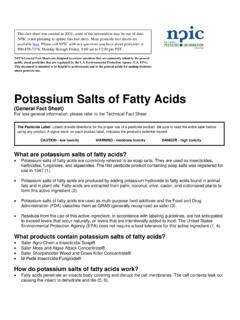Transcription of Kayexalate (sodium polystyrene sulfonate) - Sanofi
1 Kayexalate Prescribing Information Page 1 of 11 PRESCRIBING INFORMATION PrKAYEXALATE (Sodium polystyrene Sulfonate) Cation - Exchange Resin Sanofi -aventis Canada Inc. 2905 Place Louis Laval, Quebec H7V 0A3 Date of Revision: July 9, 2014 Submission Control No.: 172948 s-a Version dated July 9, 2014 Kayexalate Prescribing Information Page 2 of 11 DESCRIPTION Kayexalate (sodium polystyrene sulfonate) is a cream or light brown fine powder of sodium polystyrene sulfonate. Kayexalate is a cation-exchange resin prepared in the sodium phase, with an in vivo exchange capacity of approximately 1 mmol (in vitro approximately mmol) of potassium per gram.
2 The sodium content is approximately mmol (100 mg) per gram of the drug. Kayexalate can be administered either orally or as an enema. ACTION Sodium polystyrene sulfonate is not absorbed from the gastrointestinal tract. As the resin passes through the gastrointestinal tract, the resin removes the potassium ions by exchanging it for sodium ions. Most of this action occurs in the large intestine, which excretes potassium ions to a greater degree than does the small intestine. Potassium exchange also occurs in the colon following retention of the resin, when administered as an enema. The efficiency of this process is limited and unpredictable.
3 It commonly approximates the order of 33 per cent but the range is so large that definite indices of electrolyte balance must be clearly monitored. Metabolic data are unavailable. INDICATION Kayexalate is indicated for the treatment of hyperkalemia. CONTRAINDICATIONS Kayexalate should not be administered to patients with the following conditions: serum potassium <5 mmol/L history of hypersensitivity to polystyrene sulfonate resins obstructive bowel disease Kayexalate should not be administered orally to neonates or in neonates with reduced gut motility (postoperatively or drug induced).
4 WARNINGS Gastrointestinal injuries: Cases of gastrointestinal stenosis, intestinal ischemia, ischemic colitis, rectal haemorrhage, gastrointestinal necrosis and intestinal perforation with fatal outcomes have been reported in association with Kayexalate use. The majority of these cases reported the concomitant use of sorbitol. Risk factors for gastrointestinal adverse events Kayexalate Prescribing Information Page 3 of 11 were present in many of the cases including prematurity, history of intestinal disease or surgery, hypovolemia, immunosuppressant therapy, severe burns, and renal insufficiency and failure.
5 Concomitant administration of sorbitol is not recommended (see DRUG INTERACTIONS and ADVERSE REACTIONS). Alternative therapy in severe hyperkalemia: Since effective lowering of serum potassium with Kayexalate may take hours to days, treatment with this drug alone may be insufficient to rapidly correct severe hyperkalemia associated with states of rapid tissue breakdown ( burns and renal failure). In such instances, some form of dialysis (peritoneal or hemo-) may be imperative. If hyperkalemia is so marked as to constitute a medical emergency ( serum potassium above mmol/liter), immediate treatment with intravenous glucose and insulin, or intravenous sodium bicarbonate may be necessary as a temporary measure to lower serum potassium, while other long term potassium lowering therapy is initiated.
6 Hypokalemia: Kayexalate therapy can precipitate serious potassium deficiency and the possibility of severe potassium depletion should be considered. It is therefore, imperative, to determine serum potassium levels at least daily and more frequently when indicated. Adequate clinical and biochemical control is essential during treatment especially in patients on digitalis. Therapy should be discontinued as soon as serum potassium falls below 5 mmol/L (see DRUG INTERACTIONS). Since intracellular potassium deficiency is not always reflected by serum potassium levels, the level at which treatment with Kayexalate should be discontinued must be determined individually for each patient.
7 The patient's clinical condition and electrocardiogram are important in making this determination. Early clinical signs of severe hypokalemia include a pattern of irritability, confusion and delayed thought processes. Severe hypokalemia is often associated with a lengthened Q-T interval, widening, flattening or inversion of the T wave, and the appearance of U waves on the ECG. Cardiac arrhythmias such as premature atrial, nodal and ventricular contractions and supra-ventricular and ventricular tachycardias may also occur. Marked hypokalemia can also be manifested by severe muscle weakness, at times extending into frank paralysis.
8 The toxic effects of digitalis on the heart, especially various ventricular arrhythmia and A-V nodal dissociation, are likely to be exaggerated by hypokalemia. These effects can occur even though serum digoxin concentration is within the normal range . Patients at risk from an increase in sodium load: During the resin s action in the intestinal tract, sodium is released mole for mole with potassium uptake. A single dose of Kayexalate (15 grams) contains approximately 60 mmol of sodium. Since the resin is a source of sodium, caution is advised when Kayexalate is administered to patients who cannot tolerate even a small increase in sodium loads and for whom an increase in sodium load may be detrimental ( severe congestive heart failure, severe hypertension, marked edema or renal damage).
9 In such instances compensatory restriction of sodium intake from other sources may be indicated and adequate clinical and biochemical control is essential. The calcium form of the resin may offer advantages in this situation. Kayexalate Prescribing Information Page 4 of 11 Other electrolytes disturbances: Like all cation-exchange resins, Kayexalate is not totally selective (for potassium) in its actions, and small amounts of other cations such as magnesium and calcium can also be lost during treatment. Patients receiving Kayexalate should be monitored for all applicable electrolyte disturbances.
10 Other risks: In the event of clinically significant constipation, treatment with the resin should be discontinued until normal bowel motion is resumed. Magnesium-containing laxatives should not be used (s ee DRUG INTERACTIONS). The patient should be positioned carefully when ingesting the resin, in order to avoid aspiration, which could lead to bronchopulmonary complications. Children and neonates: In neonates, Kayexalate should not be given by the oral r oute. In both children and neonates, particular care should be observed with rectal administration. Excessive dosage or inadequate dilution could result in impaction of the resin.
![Thymoglobulin (anti-thymocyte globulin [rabbit]) - …](/cache/preview/a/b/2/e/e/b/8/2/thumb-ab2eeb82468088f352549e7d8dab340f.jpg)













